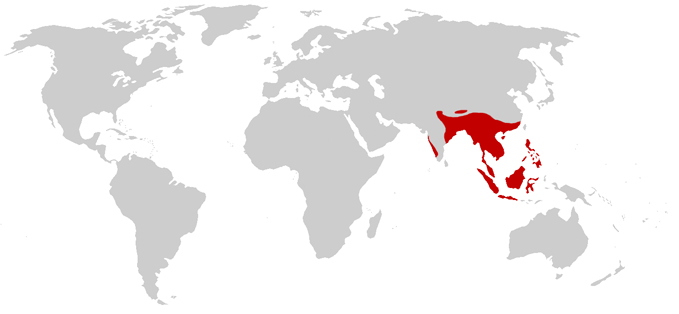 The milksnake is an unusual reptile. It comes in many different sizes and color combinations depending on where it lives. Milksnakes can be found in a wide range of habitats, from humid tropical rain forests to cool mountaintops.
The milksnake is an unusual reptile. It comes in many different sizes and color combinations depending on where it lives. Milksnakes can be found in a wide range of habitats, from humid tropical rain forests to cool mountaintops.
Physical characteristics: Although all milksnakes have smooth, shiny scales, they can look quite different from one region to the next. Some have large red or brown blotches that are often lined in black on a gray to tan background; others have bands of red, black, and yellow or white. A few are solid black. Adults range from 20 to 60 inches (51 to 152 centimeters) in length.
 |
| Coral snake vs Milk snake |
Color Variations : Most milksnake hatchlings are red with black-and-white stripes. This distinctive color pattern is similar to coral snakes, which are often found in the same places as milksnakes. Coral snakes are venomous, but milksnakes are not. In coral snakes, red and yellow bands meet, while red and black bands meet in the case of milksnakes. An easy way to remember the difference is the following mnemonic: “Red to yellow, kill a fellow: Red to black, venom lack”. For both, the bright color pattern acts as a warning signal to potential predators. The predators recognize the possible danger of being poisoned if they eat the snakes. However, hatchlings and very young milksnakes often fall victim to predators that include bullfrogs, hawks and other birds of prey, raccoons, and other snakes.
 |
| Scarlet Milk Snake |
 |
| Coral Snake |
Some milksnakes become darker in color as they grow older. Large adult milksnakes have fewer predators. The darkening happens because black pigment spreads through the red and white scales. One form—the black milksnake from Colombia becomes completely black, but most just get darker. The dark color helps the snakes to absorb heat more easily when basking. It also makes them less obvious to predators and prey.
Geographic range: Milksnakes are found across a wide range. They live in southern Canada and most of the United States, except deserts and high mountains. Milksnakes are also found throughout Central America south to the foothills of the Andes Mountains in Ecuador. In general, the largest adult milksnakes are found in warmer, tropical regions farther south. The smallest live in the northernmost parts of the snake’s range. There is one exception, however. The milksnakes found in warm, subtropical Florida are much smaller than milksnakes from the northeastern United States. The reason is that milksnakes in Florida are burrowers and live most of their lives in rotting tree stumps. A big snake would find this lifestyle difficult.
Habitat: Milksnakes are common in forests and fields, desert edges to sandy beaches and sometimes live on rocky hillsides.
Diet: Young snakes seem to prefer eating other snakes, but adults round out their diet with small mammals, lizards, and bird and reptile eggs. A milksnake typically kills mammals and lizards by constriction, which means that it coils its body around the prey animal and squeezes it to death.
Behavior and reproduction: The milksnake is a secretive animal during the day and usually stays under the bark of a tree, beneath boards, or in other small hiding places. It becomes active at night, when it feeds. Milksnakes live slightly different lives depending on where they live. Milksnakes from tropical areas are always active because the temperature is very warm throughout the year. Milksnakes from temperate regions avoid the cool winters by entering a sleeplike state called hibernation. Milksnakes hibernate for several months. They find dry, sheltered places such as woodland rabbit burrows, holes in trees, stone walls, and the cellars of buildings. Eastern milksnakes often hibernate in groups of up to twenty-eight snakes. They mate in the spring. Females lay between 4 and 15 eggs at a time, and the eggs hatch after 40–60 days. When they reach three to four years of age, the young snakes are old enough to reproduce, or have their own young.
Milksnakes and people: Although the milksnake is not dangerous, people often kill it because it defends itself by shaking its tail, striking, and biting, the type of behavior that can make people think that it is a dangerous rattlesnake. Because the snake is sometimes found in barns, people at one time had the mistaken idea that it milked cows, and so they named it the milksnake. It is sometimes collected for the pet trade.
 |
| Honduran Milk Snake |
One or many : There are about 25 forms of milksnake. They differ in size, color, stripe pattern, and where they live. The forms include the Mexican, Honduran, Ecuadorian, Pueblan, and eastern milksnakes. The eastern milksnake (shown below)â•‹is gray with brown blotches down its back. This coloration camouflages the snake against the leaf litter in which it is found. Some scientists think that milksnakes should be named as a different subspecies (types within the same species). Subspecies are isolated from each other because they live in different places. But the different milksnakes often overlap in range. The variations in size and pattern between forms are gradual so it is very tricky to say when one form ends and another begins.
 |
| Eastern Milk Snake |
Conservation status: The milksnake is not endangered or threatened.











 03.09
03.09
 fahmi adhoc
fahmi adhoc






















